Duke engineers break size barrier to print recyclable electronics

Source: interestingengineering
Author: @IntEngineering
Published: 10/17/2025
To read the full content, please visit the original article.
Read original articleDuke University engineers have developed a novel printing technique called high precision capillary printing that enables the creation of fully functional, recyclable carbon-based electronics at sub-micrometer scales. This breakthrough overcomes a previous size limitation of 10 micrometers, allowing the printing of thin-film transistors (TFTs) with features separated by tiny gaps that enhance electrical performance. The team used inks derived from nanocellulose, graphene, and carbon nanotubes, which can be printed on various substrates including glass, silicon, and flexible materials like paper. These advances could enable environmentally friendly manufacturing of electronic displays, reducing energy consumption and greenhouse gas emissions compared to traditional methods.
While the printed transistors are not intended to replace high-performance silicon chips, they show promise for applications in display technologies, particularly OLEDs, which demand higher current and multiple transistors per pixel. The technology could significantly reduce the environmental footprint of the $150 billion display industry and help revitalize U.S. manufacturing in a market currently dominated
Tags
materialsrecyclable-electronicsprinted-electronicscarbon-based-transistorsnanocellulosegraphenecarbon-nanotubes